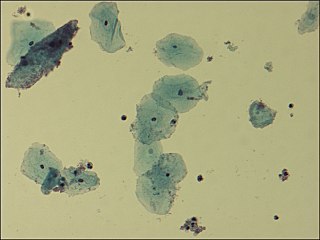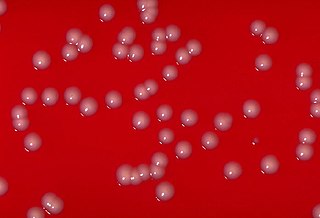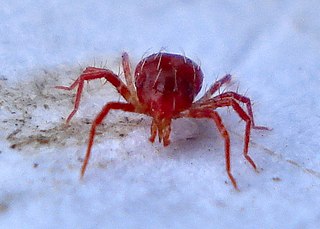
In bacteriology, gram-positive bacteria are bacteria that give a positive result in the Gram stain test, which is traditionally used to quickly classify bacteria into two broad categories according to their type of cell wall.

Gardnerella vaginalis is a species of Gram-variable-staining facultative anaerobic bacteria. The organisms are small non-spore-forming, nonmotile coccobacilli.

Corynebacterium is a genus of bacteria that are Gram-positive and most are aerobic. They are bacilli (rod-shaped), and in some phases of life they are, more specifically, club-shaped, which inspired the genus name.
The anal glands or anal sacs are small glands near the anus in many mammals, including dogs and cats. They are paired sacs on either side of the anus between the external and internal sphincter muscles. Sebaceous glands within the lining secrete a liquid that is used for identification of members within a species. These sacs are found in many species of carnivorans, including wolves, bears, sea otters and kinkajous.

The uropygial gland, informally known as the preen gland or the oil gland, is a bilobed sebaceous gland possessed by the majority of birds used to distribute the gland's oil through the plumage by means of preening. It is located dorsally at the base of the tail and is greatly variable in both shape and size. In some species, the opening of the gland has a small tuft of feathers to provide a wick for the preen oil. It is a holocrine gland enclosed in a connective tissue capsule made up of glandular acini that deposit their oil secretion into a common collector tube ending in a variable number of pores (openings), most typically two. Each lobe has a central cavity that collects the secretion from tubules arranged radially around the cavity. The gland secretion is conveyed to the surface via ducts that, in most species, open at the top of a papilla.
Mycobacterium cookii is a species of the phylum Actinomycetota, belonging to the genus Mycobacterium.
Mycobacterium elephantis, a bacterium of the family Mycobacteriaceae, was discovered and isolated from a deceased elephant near India and may be linked to respiratory dysfunction. Organisms in the genus Mycobacterium are known to be aerobic and non-motile. Organisms within Mycobacterium belong to either the rapid growing group or the slow growing group. M. elephantis is classified as a rapid grower and relates most closely to Mycobacterium confluentis and Mycobacterium phlei.
Mycobacterium hodleri is a species of the phylum Actinomycetota, belonging to the genus Mycobacterium.
Mycobacterium komossense is a species of the phylum Actinomycetota, belonging to the genus Mycobacterium.

Arcanobacterium haemolyticum is a species of bacteria classified as a gram-positive bacillus. It is catalase-negative, aerobic, beta-hemolytic, and not motile. It has been known to cause head and neck infections, pharyngitis, and sinusitis.

Skin flora, also called skin microbiota, refers to microbiota that reside on the skin, typically human skin.
Lipophilic bacteria are bacteria that may proliferate in lipids.
The Xanthobacteraceae are a family of bacteria. Among others, they include Azorhizobium, a genus of rhizobia.

Acaricomes phytoseiuli is a bacterium which is thought to be a pathogen of the mite Phytoseiulus persimilis. A. phytoseiuli causes a set of symptoms in the mite, known as nonresponding syndrome or NR syndrome. Dramatic changes in longevity, fecundity, and behavior are characteristic with this disease. The bacteria accumulate in the lumen of the mite's digestive tract and cause extreme degeneration of its epithelium. Infection with A. phytoseiuli greatly reduces the mite's attraction to herbivore-induced plant volatiles, and the mite is more prone to leave patches with ample prey. The disease is transmitted horizontally by means of feces and debris. The strain that was isolated was “CSC”. Differences between strain CSC compared to its closest phylogenetic neighbors are as follows: CSC uses glucose-1-phosphate and L-glutamic acid, and its colonies are more yellow in appearance as compared to its phylogenetic neighbors which are more cream/white in color.
Paenibacillus tylopili is a soil-dwelling, Gram-positive, rod-shaped bacterium. Described as new to science in 2008, it was found in the mycorhizosphere of the bolete fungus Tylopilus felleus.
Rathayibacter toxicus is a phytopathogenic bacterium known for causing annual ryegrass toxicity (ARGT) commonly found in South and Western Australia.
Desulfurobacterium atlanticum is a thermophilic, anaerobic and chemolithoautotrophic bacterium from the family Aquificaceae. In 2006 it was isolated from marine hydrothermal systems and proposed to become a new bacterial species.
Legionella clemsonensis was isolated in 2006, but was described in 2016 by Clemson University researchers. It is a Gram-negative bacterium.
The biochemistry of body odor pertains to the chemical compounds in the body responsible for body odor and their kinetics.
Hydrocarbonoclastic bacteria are a heterogeneous group of prokaryotes which can degrade and utilize hydrocarbon compounds as source of carbon and energy. Despite being present in most of environments around the world, several of these specialized bacteria live in the sea and have been isolated from polluted seawater.






